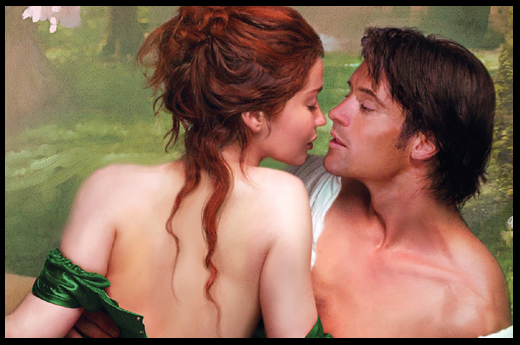
by guest blogger Maya Rodale, writer of historical tales of true love and adventure
While as a society we wonder how to motivate girls to reach higher and achieve more—especially during women’s history month—we also deride a popular and empowering form of literature regularly read by 40 million Americans. Romance novels, often dismissed as antifeminist, were actually once seen as so empowering that theirs was considered a revolutionary power deserving of vigorous government response.
Many laugh at these “trashy” books without knowing why. The answer is surprising: Our cultural scorn of women’s fiction is an inherited attitude from a time when a woman’s choice and her pleasure were a threat to the status quo. The time period in question: England in the 18th and 19th centuries. Revolution was in the air (American, French, Industrial). Literacy rates were increasing and publishing was taking off. Everything was, gulp, changing.
Fear surrounded the increasing popularity of books and reading among women and poor people, particularly that of novels, which the uneducated and ignorant might mistake as an accurate guide to life. A servant girl might read the runaway bestseller Pamela by Samuel Richardson and think she can marry the Lord of the Manor and become accepted by polite society (silly girl!). Imagine a million Pamelas—a million women with the crazy idea that they can have more—and you quite possibly have the start of a revolution.
The British government tried to stop this scourge of novel-reading by instituting a series of taxes on knowledge designed to limit access to printed material and even, in the case of the Window Tax, affordable reading light. When this method failed, a campaign of scorn, ridicule, and shame was employed, so even if you dared to read these wicked books, you certainly wouldn’t discuss it. The fear is valid: Even today a recommendation from a friend or family member is the number one resource for discovering new romance novels.
What is so revolutionary about these dangerous books for girls?
Choice: The rise of the romance novel coincided with the rise of the love match marriage, which is the hallmark of the romance novel. It begs the question, if a woman can choose whom to marry, can she not make other choices about her life? Even today “a woman’s right to choose” is an incendiary phrase.
Adventure: From Pride & Prejudice to Sex and the City, the romance novel focuses on the years in a woman’s life when she is a free agent. She’s made her debut in society, but hasn’t yet settled down. These are the adventure years, when a woman belongs to no one but herself—not a husband, not kids. Glorifying this moment risks tarnishing the allure of the traditional “family unit” when some would have us believe it’s more threatened than ever before.
Great Sex: Romance novel heroines have orgasms and do not die in the end. Canonical literature is littered with heroines who have loved and lost (Juliet, Anna Karenina, Madame Bovary). Oh, we talk more about sex now, but how much of that conversation is dominated by ways to please a man in bed or the unintended health consequences? We are still a bit wary of sex with a really happy ending, especially for women.
Love of Self: Yes, a romance novel ends with “and they got married and lived happily ever after,” but the secret ingredient is the heroine’s hard-earned self-confidence to enjoy it. What’s so threatening about that? A happy, secure woman is a lot harder to sell stuff to—be it enhancing undergarments or the cork-brained idea that she needs a man to rescue her and that she needs to be wearing a size-0 dress when he does.
We know that literacy leads to empowerment, especially for women, whether in 19th-century Britain, contemporary America, or in developing countries today. The stats are clear: Give a girl an education, and she’ll save the world. Sharing engaging and inspiring stories of girls who defy expectations and live happily ever after is a powerful way to encourage them to break the rules, embrace their power, and seek happiness—but only if those stories are celebrated, not scorned.
In honor of women’s history month, I encourage you to try one of the following:
- Read your first romance novel. (It’s fun!)
- Clear off your bookshelves and donate books to your local library or charities.
- Make a donation to organizations that help girls get educated in developing countries. Check out Kiva or The Girl Effect, two organizations that are doing just that.
 Maya Rodale is the author of multiple historical romance novels, as well as the nonfiction book Dangerous Books for Girls: The Bad Reputation of Romance Novels, Explained. She has a Master’s degree from New York University and lives in Manhattan with her darling dog and a rogue of her own mayarodale.com. Her latest book is The Tattooed Duke.
Maya Rodale is the author of multiple historical romance novels, as well as the nonfiction book Dangerous Books for Girls: The Bad Reputation of Romance Novels, Explained. She has a Master’s degree from New York University and lives in Manhattan with her darling dog and a rogue of her own mayarodale.com. Her latest book is The Tattooed Duke.




Something I’ve noticed: Romances are the female equivalent of The Hero’s Quest. In the myths, a boy’s initiation into manhood usually involves conquering something — sex is not a part of that process. (“Harry Potter” is a modern-day example.) But when the protagonist is a girl, her initiation into womanhood IS her first sexual experience: see Cupid and Psyche, Hades and Persephone, right down to Edward and Bella. In my own rock opera based on the Persephone myth, Persephone is so overflowing with joy after her “first night” with Hades, it becomes contagious to all she touches — resulting in her discovery that she can restore life to the Spectres of the Underworld.